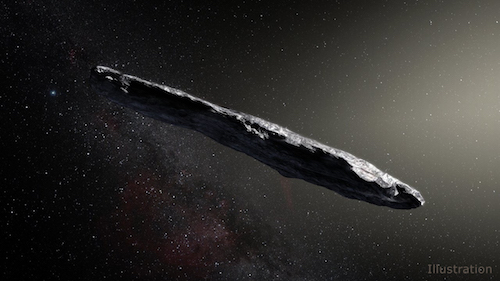OUR FIRST INTERSTELLAR VISITOR
/NASA JPL artist's illustration
Some of us believe that our solar system has had visitors from other stars, and others don’t. But last month there was concrete proof.
(Actually, it’s probably rock, not concrete, but it is real and it came from “way out there”.)
It’s an asteroid given the name Oumuamua (a Hawaiian word meaning “a messenger from afar arriving first”) discovered by the Pan-STARRS1 observatory in Maui on October 19, 2017. Not a spaceship full of alien invaders, thankfully, but still pretty interesting because it’s the first confirmed sighting of an object passing through our solar system that we know came from beyond its borders. Oumuamua’s regular changes in brightness lead scientists to believe that it’s probably cigar-shaped, perhaps four hundred meters long (about the size of a very large aircraft carrier) and rotating along its length. None of the asteroids in our system are that shape, which only adds to the mystery. It hurtled around the sun in a path resembling a comet’s orbit but it has no tail or accompanying gas cloud, and it entered the system from far above the plane of the ecliptic (the disk-like zone in which the planets and most other material orbit the sun). It wasn’t spotted until after it had already passed close to the sun, a swing-by that gave it much greater speed and a whole new direction. Don’t worry, it’s not going to come anywhere near Earth, although some scientists are so excited about it that they’re proposing an urgent effort to send a rocket chasing after it.
That probably won’t happen, firstly because such projects can’t be put together overnight, and secondly, because the chase rocket would have to go faster than any man-made object yet created. Still, you can understand their interest. Oumuamua is already changing thinking about the composition of solar systems, and who knows what else we could learn with a good close look? Think of how long it must have been wandering through the void; an orphan; a leftover from the formation of another star, flung away from its home by a Neptune-like planet. Even if it isn’t occupied by anything living, it could provide a lot of physical evidence about conditions long ago in a [star system] far, far away.
A science fiction reader learning of Oumuamua will inevitably be reminded of Arthur C. Clarke’s landmark 1973 novel Rendezvous With Rama, which won just about every SFF award that ever existed. In the novel, a 50-kilometer-long cylindrical object is discovered passing through the solar system and is found to be a mammoth spacecraft—pretty much an artificial world in a big can (reminiscent of a space colony design that’s known as an O’Neill cylinder). Coincidentally, in the story Rama is discovered by a (then fictional) program called Spaceguard tasked with finding and tracking space objects that might threaten Earth—exactly the same job the Pan-STARRS1 observatory was doing when it found Oumuamua!
Could the roving asteroid actually be an alien spacecraft? Well, there haven’t been any signs of that, but we don’t know nearly enough about it to give a definitive No either. And I’m certain that such a possibility has crossed the minds of those scientists so eager to send a reconnaissance mission after it. How could they help but wonder? Unfortunately, Clarke’s book is set in 2131 when spacecraft technology is capable of chasing and catching up with Rama. Our century has seen the Rosetta space probe rendezvous with comet 67P/Churyumov–Gerasimenko—an outstanding feat—but we’re just not up to sending a team of explorers after Oumuamua.
There are similar SF stories, including an excellent novel by Greg Bear called Eon and its sequels, which tell of a giant hollowed-out asteroid that appears in orbit around Earth and includes a long corridor that may lead beyond this universe. Don’t be surprised to see more such tales to come, inspired by the discovery of Oumuamua. Especially since the asteroid approached from a direction called the solar apex, a point in the sky toward which the solar system moves in its orbit through the galaxy.
Which means that wherever Oumuamua came from, we’re headed that way!



